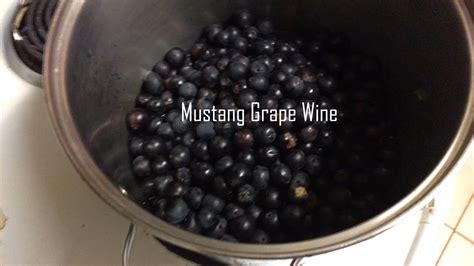How To Make Mustang Grape Wine
Ronan Farrow
Apr 01, 2025 · 3 min read

Table of Contents
How to Make Mustang Grape Wine: A Comprehensive Guide
Mustang grapes, known for their intense flavor and high acidity, are a fantastic choice for homemade wine. This comprehensive guide will walk you through the process of crafting your own delicious Mustang grape wine, from harvesting to bottling. Let's get started!
Gathering Your Supplies: Essential Equipment and Ingredients
Before you begin, ensure you have all the necessary equipment and ingredients. Improper equipment can lead to unwanted flavors or spoilage. This is where precision meets passion!
Essential Equipment:
- Primary Fermenter: A large food-grade bucket (at least 6 gallons) with a lid.
- Airlock: Crucial for preventing unwanted bacteria and oxidation during fermentation.
- Siphon tubing: For transferring wine between containers without disturbing the sediment.
- Bottles: Clean, sanitized glass bottles are essential for storing your finished wine.
- Bottling bucket: For easy filling of the bottles.
- Hydrometer: Measures the sugar content (specific gravity) of the must and finished wine.
- Bottling bucket: A separate bucket to facilitate easy bottling.
- Sanitizer: Star San or similar sanitizer is critical for maintaining hygiene throughout the process.
- Corker: For sealing the bottles properly.
- Wine Thief: For sampling without disturbing the sediment.
Essential Ingredients:
- Ripe Mustang Grapes: The foundation of your wine! Aim for fully ripe grapes with minimal damage.
- Yeast: Specifically designed wine yeast (choose one suited for high-acid grapes).
- Yeast Nutrient: Provides essential nutrients for healthy yeast fermentation.
- Campden Tablets (Potassium Metabisulfite): Used for sanitization and to prevent unwanted bacteria and oxidation.
- Sugar (optional): May be needed to adjust the sugar content depending on the grape's ripeness.
- Pectic Enzyme (optional): Helps clarify the wine by breaking down pectin in the grapes.
Step-by-Step Winemaking Process: From Harvest to Bottle
This detailed guide will lead you through the process, ensuring a smooth and successful winemaking experience. Patience and attention to detail are key.
1. Harvesting and Crushing:
- Harvest at peak ripeness: This is crucial for the best flavor and sugar content.
- Gentle crushing: Avoid excessive crushing to prevent the release of bitter tannins. You can use a crusher or simply crush the grapes by hand.
2. Primary Fermentation:
- Sanitize everything: Thoroughly sanitize all equipment before use.
- Add Campden tablets: Follow package instructions for dosage.
- Add Pectic Enzyme (optional): If using, follow the instructions on the product packaging.
- Add yeast nutrient: Provides the yeast with essential nutrients.
- Add yeast: Once the must has cooled to the proper temperature (typically around 68-72°F or 20-22°C), carefully pitch (add) your chosen wine yeast.
- Monitor fermentation: Monitor the airlock activity. Vigorous bubbling indicates active fermentation.
3. Secondary Fermentation & Aging:
- Racking: Once primary fermentation is complete (typically 2-4 weeks), siphon the wine off the sediment into a secondary fermenter.
- Aging: Allow the wine to age in a cool, dark place for several months or even years, depending on your desired flavor profile.
4. Bottling:
- Sanitize bottles and equipment: Thoroughly sanitize all bottling equipment.
- Bottle the wine: Carefully siphon the wine into the sanitized bottles, leaving a small headspace.
- Cork and seal: Cork the bottles securely.
5. Enjoy Your Homemade Mustang Grape Wine!
After several months of aging, your Mustang grape wine will be ready to enjoy. The aging process will further refine the flavor and smooth out any harshness. Remember, patience is key!
Troubleshooting Common Winemaking Issues
While winemaking is rewarding, challenges can arise. Here's how to tackle common issues:
- Stuck Fermentation: If fermentation stops prematurely, add more yeast nutrient or consider adjusting the temperature.
- Cloudy Wine: Proper fining agents can help clear the wine.
- Off-Flavors: Ensure proper sanitation and follow the instructions carefully.
By following these steps, you'll be well on your way to producing a delicious batch of homemade Mustang grape wine. Cheers to your winemaking journey!
Featured Posts
Also read the following articles
| Article Title | Date |
|---|---|
| How To Keep Raccoons From Climbing Downspouts | Apr 01, 2025 |
| How To Measure Your Length Of Pull For A Shotgun | Apr 01, 2025 |
| How To Keep Moisture Out Of A Gun Safe | Apr 01, 2025 |
| How To Preserve A Crab Shell | Apr 01, 2025 |
| How To Make Puerto Rican Ham | Apr 01, 2025 |
Latest Posts
-
How Do You Get Rid Of Insulation
Apr 04, 2025
-
How Do You Get Popes Into A Volkswagen
Apr 04, 2025
-
How Do You Get Mums To Come Back Every Year
Apr 04, 2025
-
How Do You Get Creosote Out Of Clothes
Apr 04, 2025
-
How Do You Get Conservatorship Over A Parent
Apr 04, 2025
Thank you for visiting our website which covers about How To Make Mustang Grape Wine . We hope the information provided has been useful to you. Feel free to contact us if you have any questions or need further assistance. See you next time and don't miss to bookmark.
